Useful technology was a high priority at this year's various auto shows. With some well-known and well-respected brand names falling like lead balloons in various owner surveys, great pains were taken to explain new technologies and their respective benefits.
What is useful technology? It's something that assists the driver's eyes, ears, and equilibrium, though not necessarily required for basic vehicle function. In some cases, it might seem like a complicated replacement for simple common sense, but there are always reasons why manufacturers choose these upgrades.
The technologies profiled here, in no particular order, represent the trends in vehicle design, that, like it or not, could one day become standard equipment on your truck.
Better Ride Through SoundBose, the company best known for its audio wares, is developing an electromagnetic semi-active suspension that could be the single most important suspension improvement since the invention of the leaf spring. A large electromagnetic strut at each corner absorbs road imperfections, altering the voltage as it detects up and down forces on the wheels; as a result, it pushes down or pulls up the wheel to smooth the road or flatten a tight corner. The system is proactive enough to counter driver-induced pitch, roll, or dive, and reactive enough to wipe away road-surface irregularities, bumps, or dips. We're told the drain on the engine is less than two horsepower and could make it to a production vehicle later this decade (we're guessing in a Cadillac product).
Cadillac, Lexus, and at least one motorhome builder have offered night vision, but at Pentagon-like prices ($1750 to $6860) it has not been a huge seller--yet. The Lexus system uses near-infrared cameras, while Cadillac and others have a Raytheon-based system with refractive lenses to direct infrared energy at a receiver. Either method recognizes heat (from people, animals, or vehicles) and displays it as an image, before any headlamp could illuminate the object. Night vision for the masses is still in its infancy, but we anticipate more of it for use in inclement weather and to help avoid repair costs from collisions with deer or livestock.
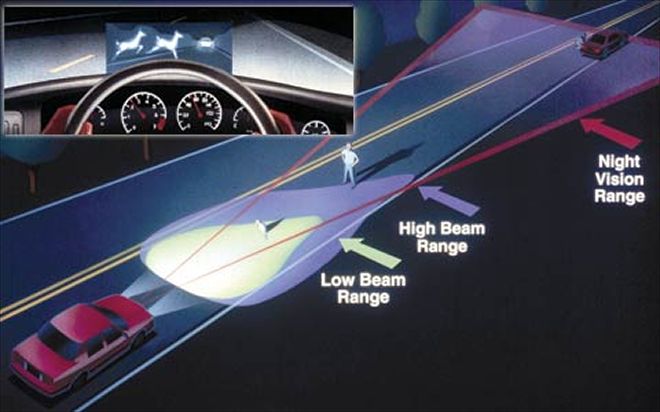
| Click above image for zoom
Part of Ford's Tow Command package is an integrated trailer-brake controller. This affords two major benefits: One, there's no question about wiring and what it may do to your truck or trailer, and two, trailer braking was programmed to match the truck by the people who built it. The controller gets input from multiple sources, including truck-brake hydraulic pressure and ABS function, and delivers the ideal trailer-brake power for the shortest stops in any condition. The sole potential drawback is that it isn't compatible with all trailer-brake systems, particularly some newer disc-brake systems. We expect this to be addressed before it becomes the towing equivalent of DVD.
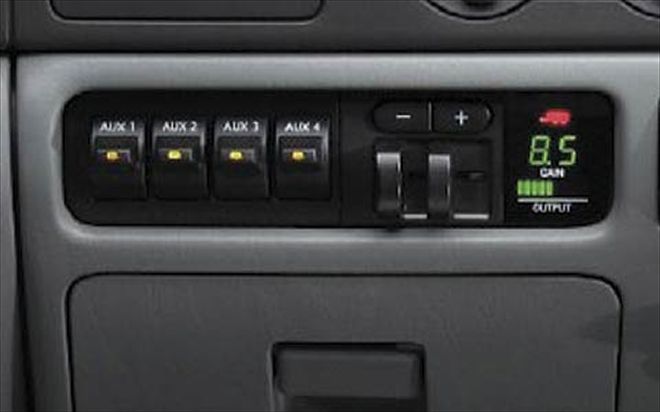
| Click above image for zoom
A long-known trick of the Saturday and Sunday afternoon tailgate expert, inverters that change 12-volt battery current into 110-volt plug-in current have been running televisions, grills, and even popcorn poppers for several decades. They've been so common in motorhomes and travel trailers, we don't know why they haven't made it into every big SUV and pickup. Many import cars and smaller sport/utes are offering 400-watt/110-volt converters as part of convenience options, but we're most impressed with the systems that allow for greater capacity, such as in the Chevy Silverado Hybrid, which offers four 110-volt outlets (two in the bed, two in the cab). A Dodge Ram contractor special also will have a similar system, but won't go on sale for a few months.
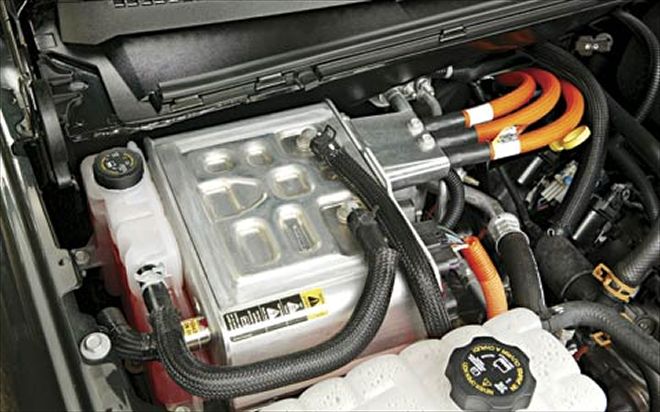
| Click above image for zoom
Although fully electric powertrains looked to be the technology of the future a few years ago, half-internal combustion/half-electric assist now seems to be the leader. Until battery-pack technology makes several discovery leaps, assisted drive seems to be the target all manufacturers will be aiming for. With Toyota announcing it'll eventually offer a hybrid system in every vehicle it currently produces, it won't be long before others follow. Naturally, we like the idea of an electric generator on board, but wouldn't mind if there were some way our cars could contribute to our household needs as well.
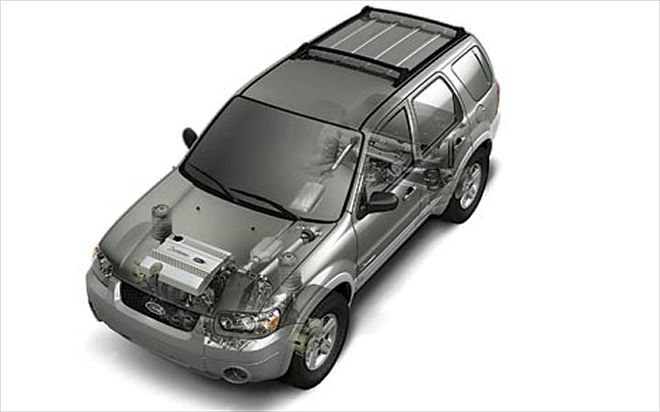
| Click above image for zoom
The NIVOMAT system from ZF Sachs offers a spring/damper system that automatically adjusts to every load situation without any external power sources. It does it all for you, based on what you're carrying (or not carrying), almost instantly. The needed height-adjustment power comes from the action of the axle as it moves the shock through its normal jounce and rebound cycle. Not only will these NIVOMAT shocks control up and down motions, but they can react in tenths of a second to compensate for rocking or wallowing motions while towing or carrying heavy loads around corners. Fully automatic, load dependent, cost effective, and easy to install; look for these shocks to become standard equipment.
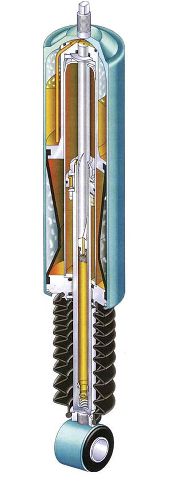
| Click above image for zoom
Continuing miniaturization of cameras brings new uses, including the rearview systems that make it simple to hitch a trailer to a QX56, RX 330, or MDX. Infiniti's FX Lane Departure Warning System now offers a camera above the rearview mirror, and, depending on lateral motion and forward distance, will provide audio and visual indicators if you leave your lane. Volvo chose digital still cameras for its Blind Spot Information System. The outside mirror units take 25 pictures per second and compare the images to determine if a vehicle is moving into a blind spot; the system's programmed to ignore parked cars and other fixed objects. As a camera-based system, it's subject to the limitations of visibility in fog and snow.
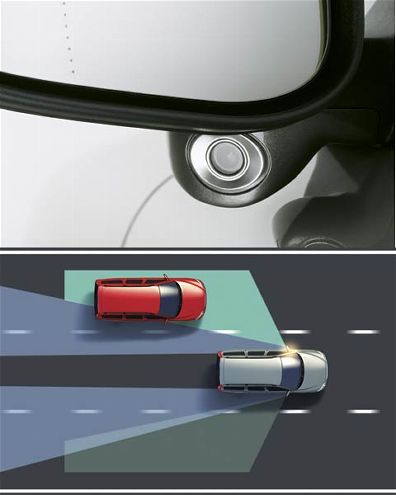
| Click above image for zoom
Another example of helpful integration is Acura's use of real-time traffic data through satellite radio in the RL sedan; similar systems will undoubtedly show up elsewhere. With every bit of current electro-tech in it, the RL can talk to your phone with Bluetooth, find food or gas, provide wonderful music and noise cancellation, and, in areas where the infrastructure supports it, show real-time traffic speeds and incidents on the navigation screen. It doesn't automatically re-route to avoid a "red" slow area or incident, but as soon as you leave the route it planned for you, it'll recalculate a new, shorter route.
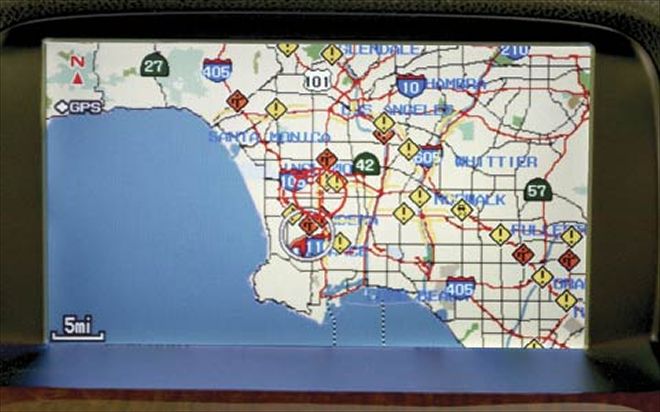
| Click above image for zoom
A few tire companies have developed run-flat tires, the most recent production example being the Michelin PAX on the Honda Odyssey. This system uses a support ring inside the tire and a bead that won't come off, even with a total loss of air pressure. It also has a monitoring unit to alert the driver in the event of pressure loss. At the NAIAS in Detroit, Michelin showed two newer designs currently being tested that could throw the whole idea of a tire into question. The Tweel is essentially a rubber tread separated from the rim by what looks like thick rubber spokes--it can absorb bumps like a regular tire, but is much stiffer laterally for better cornering and response, allowing the tire to be designed as an integral suspension unit. The airless Tweel has sidewalls, but the flexible characteristics are three-dimensional so the car doesn't have to stop, even if a radial band is compromised.
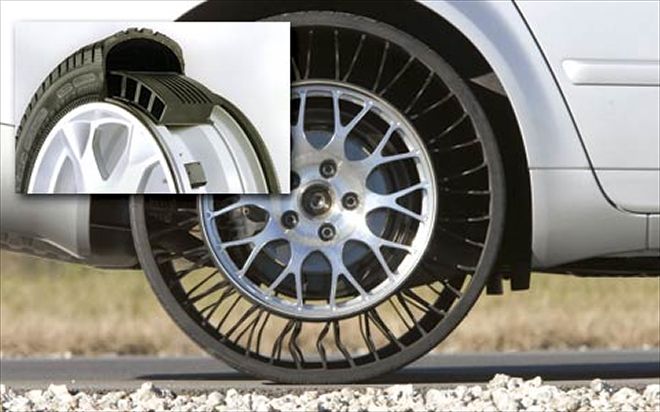
| Click above image for zoom
Land Rover's Terrain Response is the next best thing to having your very own Camel Trophy-certified chauffeur. It integrates functions previously separated into two or more areas, including ride height, engine throttle response and torque management, electronic traction control and its Hill Descent control counterpart, gearboxes, and differentials. Instead of requiring the driver to address those issues independently, Terrain Response does it all under the operation of one switch, with five choices from general pavement use to rock crawling. Some one-button systems have been tried, but Terrain Response is an excellent example of integration that works.
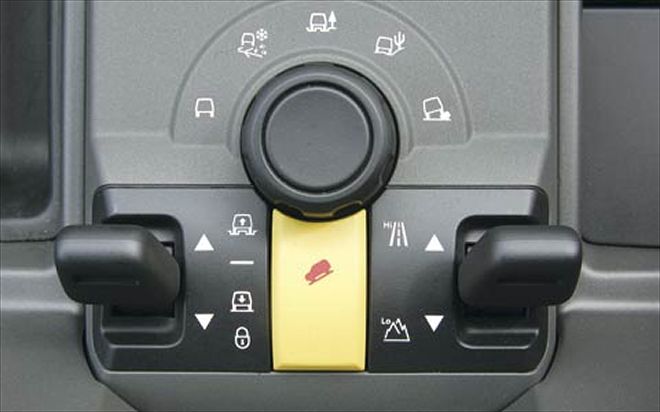
| Click above image for zoom
Electronic stability and roll control are making names for themselves. The 2005 Grand Cherokee offers both, and they use the same sensors--steering wheel position, yaw rate, and lateral acceleration--but react differently. ESP intervention is more gradual to keep the driving fun, and a good driver can complete a hard lap without ESP kicking in. However, unlike many systems, the GC's roll control is predictive. If the steering wheel is turned more quickly than the chassis can handle, roll control goes into action before a rollover accelerometer would later detect it. It happens in milliseconds, but the difference might be enough to keep your shiny side up.
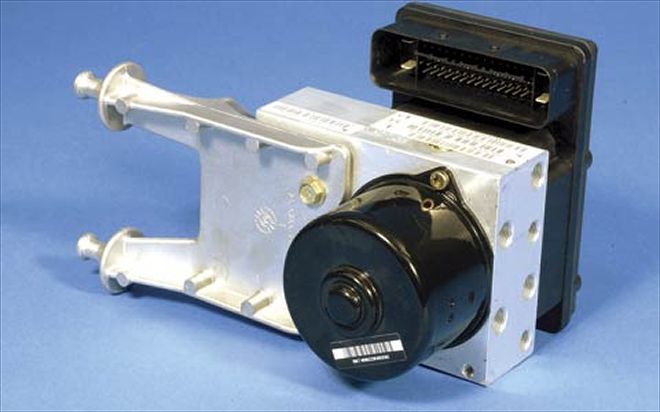
| Click above image for zoom
Series turbochargers, made popular by the Mazda RX-7, use a smaller turbo to get moderate boost for quicker response and a larger unit to generate airflow necessary for big horsepower. Electronic turbos that use a small motor to initially spool up the turbo do basically the same thing--build boost more quickly for sharper response and lower emissions. Caterpillar uses series turbos on three of its larger road engines, the biggest a 15.2-liter I-6 that makes 134 pound-feet of torque per liter. We expect most future turbos to be variable geometry, electronically assisted, or series.
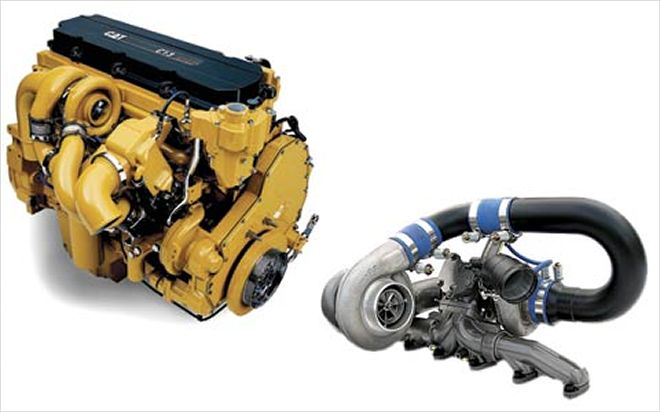
| Click above image for zoom
Technically, this isn't a new technology, but we appreciate that several pickup and SUV makers are starting to pay attention to how we use our vehicles. We don't like wasted space. We like to keep things safe and secure. And a storage space needs to hold more than a pair of gloves. We still like the lockable side-saddle storage boxes in the Chevy Avalanche (they even have drain plugs on the bottom), but also like the Nissan Titan's rear quarter-panel storage area, with a split shelf for tow straps and recovery gear. Likewise, the huge trunk in the bed of the Honda Ridgeline allows for a significant amount of gear and food to be stored and sealed from the elements. Honda was able to create a clever slide-out full-size spare-tire carrier in the same space, without limiting any cubic volume.
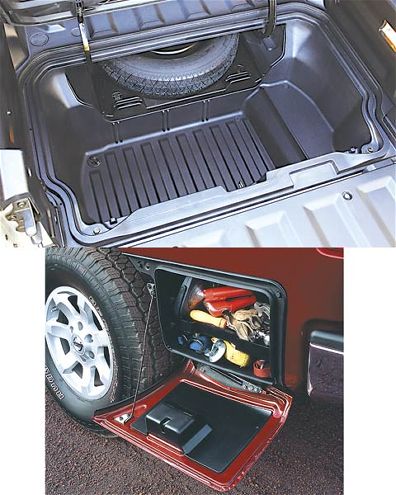
| Click above image for zoom
Springs usually consist of steel, air, or composite with predictable behavior, but the shocks that control those springs get more sophisticated every year. Last year, the 4Runner received X-REAS, a system that links opposite corner shocks, and it made the 4Runner a better high-speed road-handler and off-roader. Perhaps the best system is GM's Magnetic Ride Control, which uses electromagnetic current to change the viscosity of the shock fluid and the damping-force characteristics. Since it's electronic, the change happens in a few milliseconds for state-of-the-art ride and handling balance. One ride in a Cadillac SRX, and you'll be impressed.
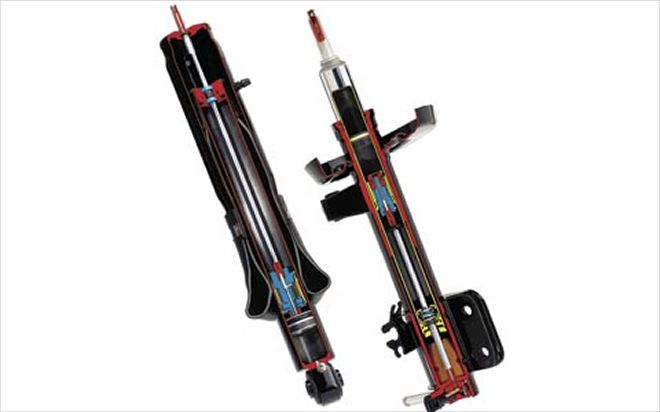
| Click above image for zoom
Under development for over 10 years, gasoline direct injection works much like a diesel engine with pressurized fuel injected straight into the cylinder, and, like diesel, tends to lower fuel consumption and increase output. It allows higher compression and lean operation (air/fuel ratio of 30:1-40:1 under low load) and may have 50 percent of the European gasoline market by 2010 as costs decrease. The BMW 760Li, MazdaSpeed6, and some 2005 Audi and VW FSI engines have it, and Isuzu offered it in 2004 Axioms and Rodeos, where it dropped NOx emissions by 87.5 percent, upped horsepower by 8.7, and improved economy by 8 percent.
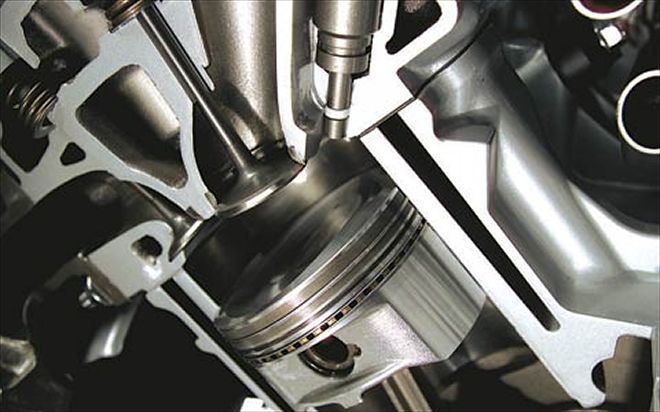
| Click above image for zoom
 | Click above image for zoom
Part of Ford's Tow Command package is an integrated trailer-brake controller. This affords two major benefits: One, there's no question about wiring and what it may do to your truck or trailer, and two, trailer braking was programmed to match the truck by the people who built it. The controller gets input from multiple sources, including truck-brake hydraulic pressure and ABS function, and delivers the ideal trailer-brake power for the shortest stops in any condition. The sole potential drawback is that it isn't compatible with all trailer-brake systems, particularly some newer disc-brake systems. We expect this to be addressed before it becomes the towing equivalent of DVD.
| Click above image for zoom
Part of Ford's Tow Command package is an integrated trailer-brake controller. This affords two major benefits: One, there's no question about wiring and what it may do to your truck or trailer, and two, trailer braking was programmed to match the truck by the people who built it. The controller gets input from multiple sources, including truck-brake hydraulic pressure and ABS function, and delivers the ideal trailer-brake power for the shortest stops in any condition. The sole potential drawback is that it isn't compatible with all trailer-brake systems, particularly some newer disc-brake systems. We expect this to be addressed before it becomes the towing equivalent of DVD.
 | Click above image for zoom
A long-known trick of the Saturday and Sunday afternoon tailgate expert, inverters that change 12-volt battery current into 110-volt plug-in current have been running televisions, grills, and even popcorn poppers for several decades. They've been so common in motorhomes and travel trailers, we don't know why they haven't made it into every big SUV and pickup. Many import cars and smaller sport/utes are offering 400-watt/110-volt converters as part of convenience options, but we're most impressed with the systems that allow for greater capacity, such as in the Chevy Silverado Hybrid, which offers four 110-volt outlets (two in the bed, two in the cab). A Dodge Ram contractor special also will have a similar system, but won't go on sale for a few months.
| Click above image for zoom
A long-known trick of the Saturday and Sunday afternoon tailgate expert, inverters that change 12-volt battery current into 110-volt plug-in current have been running televisions, grills, and even popcorn poppers for several decades. They've been so common in motorhomes and travel trailers, we don't know why they haven't made it into every big SUV and pickup. Many import cars and smaller sport/utes are offering 400-watt/110-volt converters as part of convenience options, but we're most impressed with the systems that allow for greater capacity, such as in the Chevy Silverado Hybrid, which offers four 110-volt outlets (two in the bed, two in the cab). A Dodge Ram contractor special also will have a similar system, but won't go on sale for a few months.
 | Click above image for zoom
Although fully electric powertrains looked to be the technology of the future a few years ago, half-internal combustion/half-electric assist now seems to be the leader. Until battery-pack technology makes several discovery leaps, assisted drive seems to be the target all manufacturers will be aiming for. With Toyota announcing it'll eventually offer a hybrid system in every vehicle it currently produces, it won't be long before others follow. Naturally, we like the idea of an electric generator on board, but wouldn't mind if there were some way our cars could contribute to our household needs as well.
| Click above image for zoom
Although fully electric powertrains looked to be the technology of the future a few years ago, half-internal combustion/half-electric assist now seems to be the leader. Until battery-pack technology makes several discovery leaps, assisted drive seems to be the target all manufacturers will be aiming for. With Toyota announcing it'll eventually offer a hybrid system in every vehicle it currently produces, it won't be long before others follow. Naturally, we like the idea of an electric generator on board, but wouldn't mind if there were some way our cars could contribute to our household needs as well.
 | Click above image for zoom
The NIVOMAT system from ZF Sachs offers a spring/damper system that automatically adjusts to every load situation without any external power sources. It does it all for you, based on what you're carrying (or not carrying), almost instantly. The needed height-adjustment power comes from the action of the axle as it moves the shock through its normal jounce and rebound cycle. Not only will these NIVOMAT shocks control up and down motions, but they can react in tenths of a second to compensate for rocking or wallowing motions while towing or carrying heavy loads around corners. Fully automatic, load dependent, cost effective, and easy to install; look for these shocks to become standard equipment.
| Click above image for zoom
The NIVOMAT system from ZF Sachs offers a spring/damper system that automatically adjusts to every load situation without any external power sources. It does it all for you, based on what you're carrying (or not carrying), almost instantly. The needed height-adjustment power comes from the action of the axle as it moves the shock through its normal jounce and rebound cycle. Not only will these NIVOMAT shocks control up and down motions, but they can react in tenths of a second to compensate for rocking or wallowing motions while towing or carrying heavy loads around corners. Fully automatic, load dependent, cost effective, and easy to install; look for these shocks to become standard equipment.
 | Click above image for zoom
Continuing miniaturization of cameras brings new uses, including the rearview systems that make it simple to hitch a trailer to a QX56, RX 330, or MDX. Infiniti's FX Lane Departure Warning System now offers a camera above the rearview mirror, and, depending on lateral motion and forward distance, will provide audio and visual indicators if you leave your lane. Volvo chose digital still cameras for its Blind Spot Information System. The outside mirror units take 25 pictures per second and compare the images to determine if a vehicle is moving into a blind spot; the system's programmed to ignore parked cars and other fixed objects. As a camera-based system, it's subject to the limitations of visibility in fog and snow.
| Click above image for zoom
Continuing miniaturization of cameras brings new uses, including the rearview systems that make it simple to hitch a trailer to a QX56, RX 330, or MDX. Infiniti's FX Lane Departure Warning System now offers a camera above the rearview mirror, and, depending on lateral motion and forward distance, will provide audio and visual indicators if you leave your lane. Volvo chose digital still cameras for its Blind Spot Information System. The outside mirror units take 25 pictures per second and compare the images to determine if a vehicle is moving into a blind spot; the system's programmed to ignore parked cars and other fixed objects. As a camera-based system, it's subject to the limitations of visibility in fog and snow.
 | Click above image for zoom
Another example of helpful integration is Acura's use of real-time traffic data through satellite radio in the RL sedan; similar systems will undoubtedly show up elsewhere. With every bit of current electro-tech in it, the RL can talk to your phone with Bluetooth, find food or gas, provide wonderful music and noise cancellation, and, in areas where the infrastructure supports it, show real-time traffic speeds and incidents on the navigation screen. It doesn't automatically re-route to avoid a "red" slow area or incident, but as soon as you leave the route it planned for you, it'll recalculate a new, shorter route.
| Click above image for zoom
Another example of helpful integration is Acura's use of real-time traffic data through satellite radio in the RL sedan; similar systems will undoubtedly show up elsewhere. With every bit of current electro-tech in it, the RL can talk to your phone with Bluetooth, find food or gas, provide wonderful music and noise cancellation, and, in areas where the infrastructure supports it, show real-time traffic speeds and incidents on the navigation screen. It doesn't automatically re-route to avoid a "red" slow area or incident, but as soon as you leave the route it planned for you, it'll recalculate a new, shorter route.
 | Click above image for zoom
A few tire companies have developed run-flat tires, the most recent production example being the Michelin PAX on the Honda Odyssey. This system uses a support ring inside the tire and a bead that won't come off, even with a total loss of air pressure. It also has a monitoring unit to alert the driver in the event of pressure loss. At the NAIAS in Detroit, Michelin showed two newer designs currently being tested that could throw the whole idea of a tire into question. The Tweel is essentially a rubber tread separated from the rim by what looks like thick rubber spokes--it can absorb bumps like a regular tire, but is much stiffer laterally for better cornering and response, allowing the tire to be designed as an integral suspension unit. The airless Tweel has sidewalls, but the flexible characteristics are three-dimensional so the car doesn't have to stop, even if a radial band is compromised.
| Click above image for zoom
A few tire companies have developed run-flat tires, the most recent production example being the Michelin PAX on the Honda Odyssey. This system uses a support ring inside the tire and a bead that won't come off, even with a total loss of air pressure. It also has a monitoring unit to alert the driver in the event of pressure loss. At the NAIAS in Detroit, Michelin showed two newer designs currently being tested that could throw the whole idea of a tire into question. The Tweel is essentially a rubber tread separated from the rim by what looks like thick rubber spokes--it can absorb bumps like a regular tire, but is much stiffer laterally for better cornering and response, allowing the tire to be designed as an integral suspension unit. The airless Tweel has sidewalls, but the flexible characteristics are three-dimensional so the car doesn't have to stop, even if a radial band is compromised.
 | Click above image for zoom
Land Rover's Terrain Response is the next best thing to having your very own Camel Trophy-certified chauffeur. It integrates functions previously separated into two or more areas, including ride height, engine throttle response and torque management, electronic traction control and its Hill Descent control counterpart, gearboxes, and differentials. Instead of requiring the driver to address those issues independently, Terrain Response does it all under the operation of one switch, with five choices from general pavement use to rock crawling. Some one-button systems have been tried, but Terrain Response is an excellent example of integration that works.
| Click above image for zoom
Land Rover's Terrain Response is the next best thing to having your very own Camel Trophy-certified chauffeur. It integrates functions previously separated into two or more areas, including ride height, engine throttle response and torque management, electronic traction control and its Hill Descent control counterpart, gearboxes, and differentials. Instead of requiring the driver to address those issues independently, Terrain Response does it all under the operation of one switch, with five choices from general pavement use to rock crawling. Some one-button systems have been tried, but Terrain Response is an excellent example of integration that works.
 | Click above image for zoom
Electronic stability and roll control are making names for themselves. The 2005 Grand Cherokee offers both, and they use the same sensors--steering wheel position, yaw rate, and lateral acceleration--but react differently. ESP intervention is more gradual to keep the driving fun, and a good driver can complete a hard lap without ESP kicking in. However, unlike many systems, the GC's roll control is predictive. If the steering wheel is turned more quickly than the chassis can handle, roll control goes into action before a rollover accelerometer would later detect it. It happens in milliseconds, but the difference might be enough to keep your shiny side up.
| Click above image for zoom
Electronic stability and roll control are making names for themselves. The 2005 Grand Cherokee offers both, and they use the same sensors--steering wheel position, yaw rate, and lateral acceleration--but react differently. ESP intervention is more gradual to keep the driving fun, and a good driver can complete a hard lap without ESP kicking in. However, unlike many systems, the GC's roll control is predictive. If the steering wheel is turned more quickly than the chassis can handle, roll control goes into action before a rollover accelerometer would later detect it. It happens in milliseconds, but the difference might be enough to keep your shiny side up.
 | Click above image for zoom
Series turbochargers, made popular by the Mazda RX-7, use a smaller turbo to get moderate boost for quicker response and a larger unit to generate airflow necessary for big horsepower. Electronic turbos that use a small motor to initially spool up the turbo do basically the same thing--build boost more quickly for sharper response and lower emissions. Caterpillar uses series turbos on three of its larger road engines, the biggest a 15.2-liter I-6 that makes 134 pound-feet of torque per liter. We expect most future turbos to be variable geometry, electronically assisted, or series.
| Click above image for zoom
Series turbochargers, made popular by the Mazda RX-7, use a smaller turbo to get moderate boost for quicker response and a larger unit to generate airflow necessary for big horsepower. Electronic turbos that use a small motor to initially spool up the turbo do basically the same thing--build boost more quickly for sharper response and lower emissions. Caterpillar uses series turbos on three of its larger road engines, the biggest a 15.2-liter I-6 that makes 134 pound-feet of torque per liter. We expect most future turbos to be variable geometry, electronically assisted, or series.
 | Click above image for zoom
Technically, this isn't a new technology, but we appreciate that several pickup and SUV makers are starting to pay attention to how we use our vehicles. We don't like wasted space. We like to keep things safe and secure. And a storage space needs to hold more than a pair of gloves. We still like the lockable side-saddle storage boxes in the Chevy Avalanche (they even have drain plugs on the bottom), but also like the Nissan Titan's rear quarter-panel storage area, with a split shelf for tow straps and recovery gear. Likewise, the huge trunk in the bed of the Honda Ridgeline allows for a significant amount of gear and food to be stored and sealed from the elements. Honda was able to create a clever slide-out full-size spare-tire carrier in the same space, without limiting any cubic volume.
| Click above image for zoom
Technically, this isn't a new technology, but we appreciate that several pickup and SUV makers are starting to pay attention to how we use our vehicles. We don't like wasted space. We like to keep things safe and secure. And a storage space needs to hold more than a pair of gloves. We still like the lockable side-saddle storage boxes in the Chevy Avalanche (they even have drain plugs on the bottom), but also like the Nissan Titan's rear quarter-panel storage area, with a split shelf for tow straps and recovery gear. Likewise, the huge trunk in the bed of the Honda Ridgeline allows for a significant amount of gear and food to be stored and sealed from the elements. Honda was able to create a clever slide-out full-size spare-tire carrier in the same space, without limiting any cubic volume.
 | Click above image for zoom
Springs usually consist of steel, air, or composite with predictable behavior, but the shocks that control those springs get more sophisticated every year. Last year, the 4Runner received X-REAS, a system that links opposite corner shocks, and it made the 4Runner a better high-speed road-handler and off-roader. Perhaps the best system is GM's Magnetic Ride Control, which uses electromagnetic current to change the viscosity of the shock fluid and the damping-force characteristics. Since it's electronic, the change happens in a few milliseconds for state-of-the-art ride and handling balance. One ride in a Cadillac SRX, and you'll be impressed.
| Click above image for zoom
Springs usually consist of steel, air, or composite with predictable behavior, but the shocks that control those springs get more sophisticated every year. Last year, the 4Runner received X-REAS, a system that links opposite corner shocks, and it made the 4Runner a better high-speed road-handler and off-roader. Perhaps the best system is GM's Magnetic Ride Control, which uses electromagnetic current to change the viscosity of the shock fluid and the damping-force characteristics. Since it's electronic, the change happens in a few milliseconds for state-of-the-art ride and handling balance. One ride in a Cadillac SRX, and you'll be impressed.
 | Click above image for zoom
Under development for over 10 years, gasoline direct injection works much like a diesel engine with pressurized fuel injected straight into the cylinder, and, like diesel, tends to lower fuel consumption and increase output. It allows higher compression and lean operation (air/fuel ratio of 30:1-40:1 under low load) and may have 50 percent of the European gasoline market by 2010 as costs decrease. The BMW 760Li, MazdaSpeed6, and some 2005 Audi and VW FSI engines have it, and Isuzu offered it in 2004 Axioms and Rodeos, where it dropped NOx emissions by 87.5 percent, upped horsepower by 8.7, and improved economy by 8 percent.
| Click above image for zoom
Under development for over 10 years, gasoline direct injection works much like a diesel engine with pressurized fuel injected straight into the cylinder, and, like diesel, tends to lower fuel consumption and increase output. It allows higher compression and lean operation (air/fuel ratio of 30:1-40:1 under low load) and may have 50 percent of the European gasoline market by 2010 as costs decrease. The BMW 760Li, MazdaSpeed6, and some 2005 Audi and VW FSI engines have it, and Isuzu offered it in 2004 Axioms and Rodeos, where it dropped NOx emissions by 87.5 percent, upped horsepower by 8.7, and improved economy by 8 percent.
 | Click above image for zoom
| Click above image for zoom